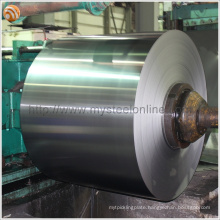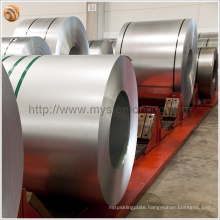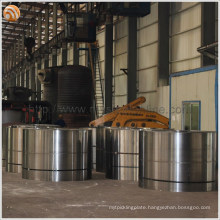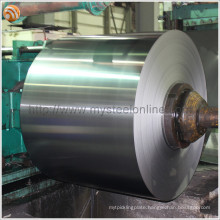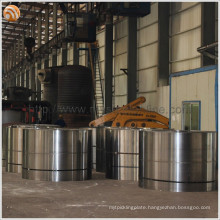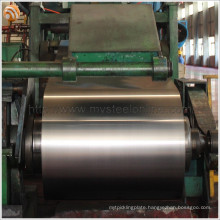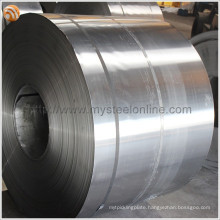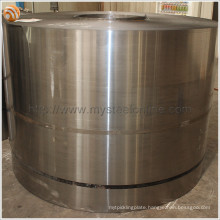Steel terminology
2021-05-23
Eutectoid steel
Carbon dissolves in the lattice of iron to form a solid solution. The solid solution in which carbon is dissolved into α-iron is called ferrite, and the solid solution dissolved in γ-iron is called austenite. Both ferrite and austenite have good plasticity. When the iron-carbon alloy of carbon or not ferrite austenite all dissolved, the remaining carbon will be formed out of an iron compound and - iron carbide (Fe3C) crystal structure of this compound is called cementite, it The hardness is extremely high and the plasticity is almost zero.
From the iron-carbon equilibrium state diagram reflecting the relationship between the microstructure of steel and the carbon content of steel and the temperature of steel, it can be seen that when the carbon content is exactly equal to 0.77%, it is equivalent to cementite (iron carbide) in the alloy. When the proportion is about 12% and the ferrite is about 88%, the phase transformation of the alloy is achieved at a constant temperature. That is, cementite and ferrite at this specific ratio, if a phase change occurs, if both disappear at the same time (when heated), if they appear, both appear at the same time, at which point the tissue The phase transition of pure metals is similar. For this reason, the two-phase structure composed of a specific ratio is regarded as a kind of organization, and named as pearlite, this steel is called eutectoid steel. That is, steel with a carbon content of 0.77% is called eutectoid steel, and its structure is pearlite.
2. Eurasian steel
Commonly used structural steels have a carbon content of less than 0.5%. Since the carbon content is less than 0.77%, the amount of cementite in the structure is less than 12%. Therefore, part of the ferrite is removed to form pearlite with cementite. There will be extra appearance, so the structure of this steel is ferrite + pearlite. The lower the carbon content, the smaller the proportion of pearlite in the steel structure, and the lower the strength of the steel, but the better the plasticity. These steels are called hypoeutectoid steel.
3. Hypereutectoid steel
The carbon content of tool steel often exceeds 0.77%. The proportion of cementite in this steel structure exceeds 12%. Therefore, in addition to the formation of pearlite with ferrite, there is excess cementite, so the structure of such steel. It is pearlite + cementite. This type of steel is called hypereutectoid steel.
2. Terms related to the mechanical properties of steel
Yield point (σs)
When the steel or sample is stretched, when the stress exceeds the elastic limit, even if the stress does not increase any more, the steel or the sample continues to undergo significant plastic deformation, which is called the yield, and the minimum stress value when the yield phenomenon occurs is To yield points.
Let Ps be the external force at the yield point s, Fo be the sample cross-sectional area, then the yield point σs=Ps/Fo(MPa), MPa is called MPa equal to N(Newton)/mm2, (MPa=106Pa, Pa: Pascal =N/m2)
2. Yield strength (σ0.2)
Some metal materials have a very low yield point and are difficult to measure. Therefore, in order to measure the yield characteristics of the material, it is specified that the permanent residual plastic deformation is equal to a certain value (generally 0.2% of the original length). The yield strength or simply the yield strength σ0.2.
3. Tensile strength (σb)
The maximum stress value achieved by the material during the stretching process from the beginning to the time of the fracture. It indicates the ability of the steel to resist fracture. Corresponding to the tensile strength, there are compressive strength, bending strength, and the like. Let Pb be the maximum tensile force reached before the material is broken. Fo is the cross-sectional area of the specimen, and the tensile strength σb = Pb/Fo (MPa).
4. Elongation (δs)
After the material is broken, the length of the plastic elongation and the length of the original sample are called elongation or elongation.
5. Yield ratio (σs/σb)
The ratio of the yield point (yield strength) of the steel to the tensile strength is called the yield ratio. The higher the yield ratio, the higher the reliability of the structural parts. The general Carbon Steel yield ratio is 0.6-0.65, and the low alloy structural steel is 0.65-0.75 alloy structural steel is 0.84-0.86.
6. Hardness
Hardness indicates the ability of a material to resist the pressing of a hard object into its surface. It is one of the important performance indicators of metallic materials. Generally, the higher the hardness, the better the wear resistance. Commonly used hardness indexes are Brinell hardness, Rockwell hardness and Vickers hardness.
(1) Brinell hardness (HB)
A certain size (usually 3000kg) of a hardened steel ball of a certain size (typically 10mm in diameter) is pressed into the surface of the material for a period of time. After the load is removed, the ratio of the load to the area of the indentation is the Brinell hardness value ( HB), the unit is kilogram force / mm2 (N / mm2).
(2) Rockwell hardness (HR)
When HB>450 or the sample is too small, the Brinell hardness test cannot be used instead of the Rockwell hardness measurement. It uses a diamond cone with a apex angle of 120° or a steel ball with a diameter of 1.59 and 3.18 mm, and is pressed into the surface of the material to be tested under a certain load, and the hardness of the material is determined from the depth of the indentation. According to the hardness of the test material, it is represented by three different scales:
HRA: It is a hardness obtained by using a 60kg load and a diamond cone indenter for materials with extremely high hardness (such as cemented carbide).
HRB: It is a hardened steel ball with a load of 100kg and a diameter of 1.58mm. The hardness is used for materials with lower hardness (such as annealed steel, cast iron, etc.).
HRC: is the hardness obtained by using a 150kg load and a diamond cone indenter for materials with high hardness (such as hardened steel).
(3) Vickers hardness (HV) The surface of the material is pressed into the surface of the material with a load of 120 kg or less and a diamond square cone presser with a apex angle of 136°. The surface area of the material indentation pit is divided by the load value, which is the Vickers hardness value ( HV)
Third, the terminology of heat treatment of steel
1. Annealing of steel The steel is heated to a certain temperature and kept for a while, then it is slowly cooled, called annealing. Annealing of steel is a heat treatment method in which steel is heated to a temperature at which a phase change or a partial phase change occurs, and is slowly cooled after being kept warm. The purpose of annealing is to eliminate tissue defects, improve the structure to homogenize the components and refine the grains, improve the mechanical properties of the steel, reduce the residual stress, and at the same time reduce the hardness, improve the plasticity and toughness, and improve the cutting performance. Therefore, in order to eliminate and improve the structural defects and internal stress left in the previous process, and to prepare for the subsequent process, the annealing is a semi-finished heat treatment, also known as pre-heat treatment.
2. Normalizing of steel Normalizing is a heat treatment method in which the steel is heated above the critical temperature to completely transform the steel into uniform austenite and then naturally cool in the air. It can eliminate the network cementite of hypereutectoid steel. It can be used to refine the crystal lattice of hypoeutectoid steel and improve the comprehensive mechanical properties. It is economical to replace the annealing process with the normalized fire for the less demanding parts.
3. Quenching quenching of steel is to heat the steel above the critical temperature, keep it for a period of time, and then quickly put it into the quenching agent, so that its temperature suddenly drops, and it is rapidly cooled at a speed greater than the critical cooling rate to obtain martensite. Main heat treatment method for unbalanced tissue. Quenching increases the strength and hardness of steel, but reduces its ductility. Quenching agents commonly used in quenching are: water, oil, alkaline water and salt solutions.
4. Tempering of steel Reheating the quenched steel to a certain temperature and then cooling it by a certain method is called tempering. Its purpose is to eliminate the internal stress generated by quenching and reduce the hardness and brittleness to achieve the expected mechanical properties. The tempering is divided into three categories: high temperature tempering, medium temperature tempering and low temperature tempering. The tempering is mostly used in combination with quenching and normalizing.
(1) Quenching and tempering treatment: The heat treatment method of high temperature tempering after quenching is called quenching and tempering treatment. High temperature tempering refers to tempering between 500-650 °C. Quenching and tempering can make the properties and materials of steel get a large degree of adjustment, and its strength, plasticity and toughness are good, and it has good comprehensive mechanical properties.
(2) Aging treatment: In order to eliminate the change of size and shape of precision measuring tools or molds and parts in long-term use, the workpiece is reheated to 100-150 before finishing after low temperature tempering (low temperature tempering temperature 150-250 °C). °C, for 5-20 hours, this process for stabilizing the quality of precision parts is called aging. It is especially important to aging the steel components under low temperature or dynamic load conditions to eliminate residual stress and stabilize the steel structure and size.
5. Surface heat treatment of steel
(1) Surface quenching: the surface of the steel is rapidly heated to above the critical temperature, but the heat is quickly cooled before it is transmitted to the core, so that the surface layer can be quenched in the martensite structure without the heart occurring. The phase change, which achieves the purpose of surface hardening and the core is unchanged. Suitable for medium carbon steel.
(2) Chemical heat treatment: refers to the ability of atoms of chemical elements to penetrate into the surface layer of the workpiece by means of the ability to diffuse atoms at high temperatures to change the chemical composition and structure of the surface layer of the workpiece, so as to achieve a specific surface layer of the steel. A heat treatment process that requires tissue and performance. According to the type of infiltrating elements, chemical heat treatment can be divided into four types: carburizing, nitriding, cyanidation and metallizing.
Carburizing: Carburizing refers to the process of infiltrating carbon atoms into the surface layer of steel. It also makes the low carbon steel workpiece have the surface layer of high carbon steel, and after quenching and low temperature tempering, the surface layer of the workpiece has high hardness and wear resistance, while the central part of the workpiece still maintains the toughness of low carbon steel. Plasticity.
Nitriding: Also known as nitriding, it is a process of infiltrating nitrogen atoms into the surface layer of steel. The purpose is to improve the hardness and wear resistance of the surface layer as well as to improve fatigue strength, corrosion resistance and the like. Gas nitriding is often used in production.
Cyanide: Also known as carbonitriding, it refers to the process of simultaneously infiltrating carbon and nitrogen atoms into steel. It gives the steel surface the characteristics of carburizing and nitriding.
Metal infiltration: refers to the process of infiltrating a surface layer of steel with metal atoms. It is to alloy the surface layer of steel to make the surface of the workpiece have certain alloy steel and special steel characteristics, such as heat resistance, wear resistance, oxidation resistance and corrosion resistance. Commonly used in the production of aluminized, chromizing, boriding silicon.
Annealed steel bar is produced by annealing which is one kind of heat treatment to get proper hardness for machining. Our advantages and more services of annealed steel bar includes:
1) Wide range of diameters from 10mm to 300mm
2) Customized Length from 100mm to 12000mm
3) Good surface roughness: 0.4um to 1.5um
4) Good straightness: 0.5mm/m to 2mm/m
5) Good roundness: 80% of diameter tolerance
6) Diameter tolerance: -0.02mm to -0.06mm/h9, h10, h11
7) Matched further processing: Grinding, polishing, straightening
8) Anti-rusty package
9) Full sets of testing equipment: Surface, Dimenstion. Mechanical properties testing
10) Fast delivery time
Annealed Steel Round Bar, Annealed Steel Bar, Hot Rolled Annealed Steel, Cold Drawn Annealed Steel, Annealed Steel Rod
Cold Rolled Strip Co., Ltd. http://www.sdcolddrawnsteelbar.com
